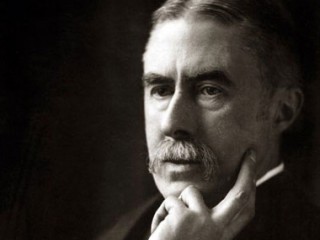
Alfred E. Housman biography
Date of birth : 1859-03-26
Date of death : 1936-04-30
Birthplace : Fockbury, Worcestershire
Nationality : British
Category : Arhitecture and Engineering
Last modified : 2010-11-21
Credited as : Poet and scholar, Thirty Hitherto Unpublished Poems (1938),
The English poet and classical scholar Alfred Edward Housman is known for the simplicity of his form and language, the narrow range of his subject matter, and the attitude of traditional stoicism which his poems present.
The eldest of seven children, A. E. Housman was born in Fockbury, Worcestershire. He entered St. John's College, Oxford, in 1877, where, after a distinguished start, and despite apparent brilliance as a classical scholar, he failed to gain his honors degree. This failure was, apparently, such a disgrace for Housman as to cause his withdrawal both from academic life and from his family to take up a post in the civil service in London. It was but one of a series of disappointments which strongly affected an acutely sensitive nature. The death of his mother when he was 12 years old disturbed him so profoundly, according to his sister, that death thereafter became an obsession with him; the death of his father in 1894 was another deeply felt loss; and the abrupt dissolution, in 1887, of his one deep, youthful friendship (with Moses Jackson) ensured his settling into a somewhat solitary, if not quite reclusive, pattern of life.
Housman's written works of Greek and Latin criticism are marked by devastating wit at the expense of professional colleagues, and those who knew him well found him a charming conversationalist. But his poetry is of a type which, like scholarship itself, emanates from a man meditative and alone.
It was a surprise to both his personal and professional acquaintances when Housman's first volume of poems, A Shropshire Lad (1896), appeared. He had taken up residence in London upon entering the civil service in 1882 and had resumed the classical studies which he had begun at Oxford. The reviews and articles on Greek and (primarily) Latin authors which he began to publish at this time were of such recognizably high quality that in 1892 he was elected to the chair of Latin at London University, where he remained until 1911. But although he was a prolific critic and editor of classical texts, he had given no indication of what he later called the "continuous excitement" under which, in 1895, he wrote a majority of the poems which appeared in his first volume.
The poems of A Shropshire Lad, in form brief pastoral lyrics of perfect simplicity, detail an obsession with the transience of the human experience. Ostensibly written by a naive rustic, and handling subjects appropriate to the rural setting of village society, they lament the loss of friends, the inevitability of death, the vanity of all human aspiration.
In 1911 Housman took the chair of Latin at Cambridge, where, as a fellow of Trinity College, he became a regular and popular lecturer in the classics and continued his editions of Latin authors and his essays on textual criticism until the time of his death. In 1922 he published a new volume of 41 lyrics, under the title Last Poems, most of which date from 1895 to 1910; one further collection, More Poems, was published after his death by the poet's brother in 1936.
In 1933, a year after his appointment to the Leslie Stephen lectureship at Cambridge, Housman delivered his lecture "The Name and Nature of Poetry, " in which he affirms that the purpose of poetry is "to transfuse motion" and that its value is not in "the thing said but a way of saying it." Such are the criteria by which Housman's own poetry should be judged, and by such criteria he is recognized among the most consummate lyricists in the English language. The very clarity and perfection of his lyrics have led some critics, like Edith Sitwell, to find them simply "bare and threadbare." But to Housman's admirers his poems represent, in a manner replete with irony and paradox, the complex emotional responses of man to a world of transience, where the only certitude is that one which is least desired—the certitude of death itself.
The seeming transparency of Housman's verse and a suspicion that his own personality and life may be the clues to deeper meanings have led to more critical and biographical studies than his output might warrant. In addition to the memoirs by Laurence Housman, My Brother, A. E. Housman: Personal Recollections, together with Thirty Hitherto Unpublished Poems (1938), and by his sister, Katherine Elizabeth Symons, Memories of A. E. Housman (1936), biographies include George L. Watson, A. E. Housman: A Divided Life (1957), and Norman Marlow, A. E. Housman, Scholar and Poet (1958). Tom Burns Haber provides a readable yet scholarly introduction to the poetry in A. E. Housman (1967). A study both broad and detailed is Bobby J. Leggett, Housman's Land of Lost Content: A Critical Study of A Shropshire Lad (1970).
Bryn Mawr College Library, The name and nature of A.E. Housman: from the collection of Seymour Adelma, Bryn Mawr, Pa.: Bryn Mawr College Library; New York, N.Y.: Pierpont Morgan Library, 1986.
Clemens, Cyril, An evening with A. E. Housman, Folcroft, Pa.: Folcroft Library Editions, 1977.
Graves, Richard Perceval, A. E. Housman, the scholar-poet, New York: Scribner, 1980, 1979.
Housman, Laurence, Alfred Edward Housman's "De amicitia, " London: Little Rabbit Book Co., 1976.
Jebb, Keith, A.E. Housman, Bridgend, Mid Glamorgan: Seren Books; Chester Springs, PA: U.S. Distributor, Dufour Editions, 1992.
Naiditch, P. G., A.E. Housman at University College, London: the election of 1892, Leiden; New York: E.J. Brill, 1988.
Naiditch, P. G., Problems in the life and writings of A. E. Housman, Beverly Hills, CA: Krown & Spellmam, 1995.
















